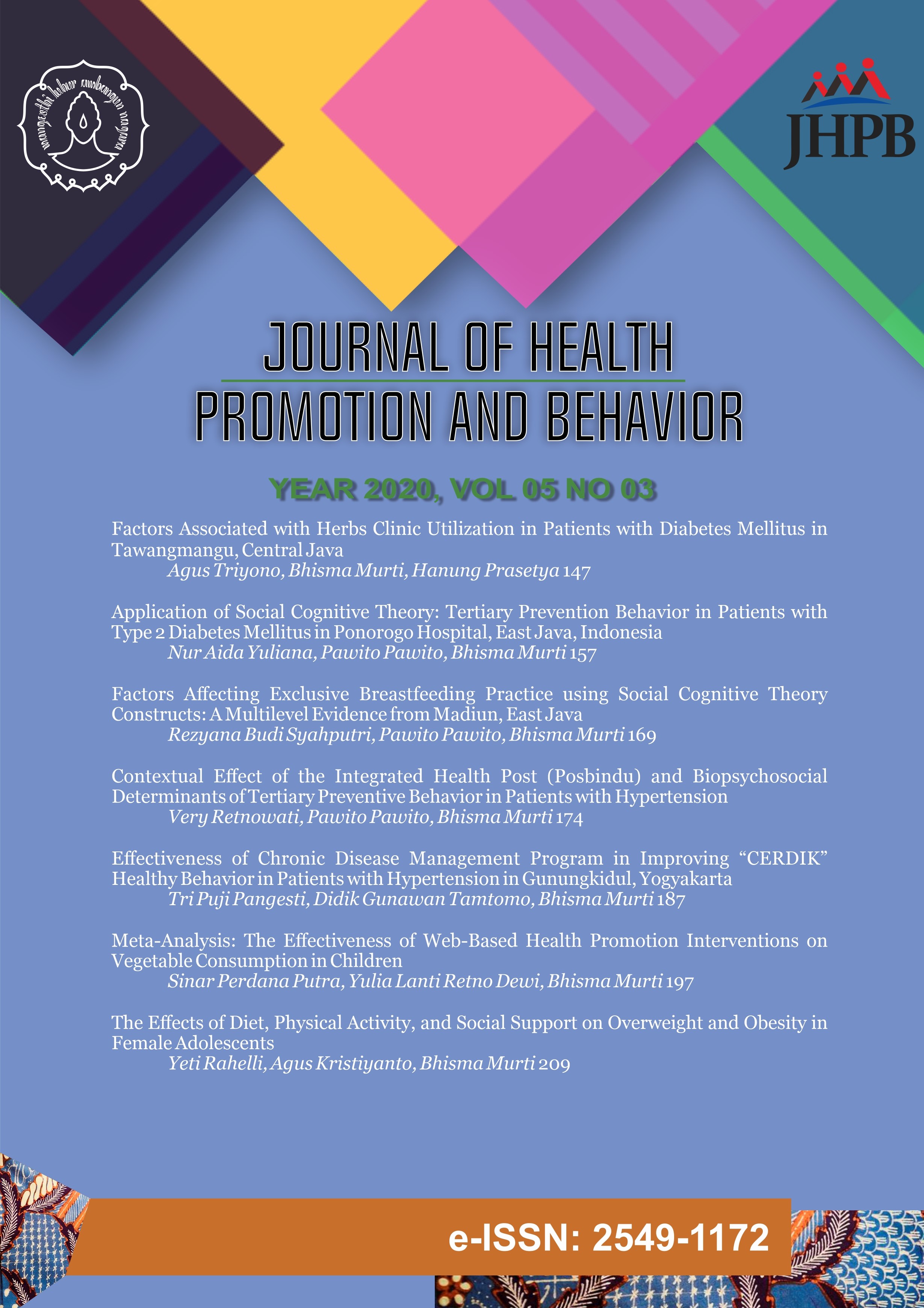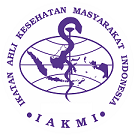Contextual Effect of the Integrated Health Post (Posbindu) and Biopsychosocial Determinants of Tertiary Preventive Behavior in Patients with Hypertension
Abstract
Background: Tertiary prevention of hypertension is a preventive effort to make patients with hypertension do not have disabilities and further complications. It also improves the quality of life and makes life longer. The biopsychosocial aspect affects individuals in learning, doing, and maintaining certain behaviors based on social cognitive theory. This study aimed to analyze the biopsychosocial determinants of tertiary preventive behavior among patients with hypertension.
Subjects and Method: This study was an analytical observational study with a cross-sectional design. The study was conducted at 25 Integrated Health Posts (Posbindu) in Sragen, Central Java. A sample of 200 hypertensive patients was selected by stratified random sampling. The dependent variable was the tertiary preventive behavior of hypertension. The independent variables were observational learning, role model, imitation, vicarious learning, reinforcement, self-efficacy, self-regulation, outcome expectation, and attitude. The data were collected by questionnaire and analyzed by a multilevel multiple logistic regression.
Results: Hypertension preventive behavior increased with observational learning (b= 2.85; 95% CI= 0.17 to 5.53; p= 0.037), role model (b= 2.73; 95% CI =0.73 to 4.73; p=0.007), imitation (b= 3.46 ; 95% CI= 0.73 to 6.19; p= 0.013), vicarious learning (b= 2.54; 95% CI =0.16 to 4.93; p= 0.036), reinforcement (b= 3.89; 95% CI= 0.96 to 6.82; p= 0.009), self-efficacy (b= 3.04; 95% CI= 0.41 to 5.67; p= 0.024), self-regulation (b= 2.28; 95% CI= 0.02 to 4.54; p= 0.048), outcome expectation (b= 3.56; 95% CI= 0.75 to 6.38; p= 0.013), and a positive attitude (b= 2.86; 95% CI= 0.26 to 5.47; p= 0.031). Posbindu had a contextual effect on tertiary preventive behavior of hypertension with an Intra Class Correlation (ICC) value of 63.05%.
Conclusion: Tertiary preventive behavior of hypertension increases with high observational learning, strong role model, strong imitation, high vicarious learning, strong reinforcement, high self-efficacy, high self-regulation, positive outcome expectation, and positive attitude. Posbindu has a contextual effect on tertiary preventive behavior of hypertension.
Keywords: tertiary prevention, hypertension, social cognitive theory, multilevel analysis
Correspondence: Very Retnowati. Masters Program in Public Health, Universitas Sebelas Maret. Jl. Ir. Sutami 36A, Surakarta 57126, Central Java. Email: veryretnowati@gmail.com. Mobile: +6281548592491.
Journal of Health Promotion and Behavior (2020), 05(03): 174-186
https://doi.org/10.26911/thejhpb.2020.05.03.04
How to Cite
References
Andriani P, Chamidah N (2019) Modelling of hypertension risk factors using logistic regression to prevent hypertension in indonesia. J Phys Conf Ser.1306(1). doi:10.1088/17426596/1-306/1/012027
Andriyaningtiyas Y, Tamtomo DG, Murti B (2020). Theory of planned behavior and social cognitive theory on the effect of the community health center tertiary preventive behavior among patients with type 2 diabetes mellitus: a multilevel analysis. J Health Promot Behav.05(01):5971.doi.org/10.26911/thejhpb.2020.05.01.08
Datta S, Sahu SK, Niranjjan R, Roy G (2019). A community-based cross sec-tional study on hypertension screening in Puducherry India. Indian J Med Res. 150(2):199-202. doi:10.4103/ijmr.IJMR.
Dewantara BP, Murti B, Widyaningsih V (2019). Application of health belief model and social cognitive theory on the use of personal protective equipment among workers at the plywood plant: path analysis evidence from Lumajang, East Java. J Health Promot Behav. 4(4):306–318.doi.org/10.26911/thejhpb.2019.04.04.07
Dinkes Prov Jateng (2018). Profil Kesehatan Provinsi Jawa Tengah Tahun 2018. Semarang: Dinas Kesehatan Provinsi Jawa Tengah.
Febrianti R, Prabawati I (2017). Implementasi pelaksanaan pos pembinaan terpadu penyakit tidak menular (posbindu ptm) di Puskesmas Pucang Sewu Kota Surabaya.Publika 5(5). Retrieved from https://jurnalmahasiswa.unesa.ac.id/index.php/publika/article/view/21022.
Ferdianto A, Tamtomo DG, Sulaeman ES (2019). Does the integrated health post have contextual effect on tertiary preventive behavior among hypertensive patients? a multilevel analysis evidence from surakarta. J Health Promot Behav. 4(3):224-234. doi:10.-26911/thejhpb.2019.04.03.07.
Geleta GT, Cheme MC, Roro EM (2019). Physical, behavioral and sociodemographic determinants of hypertension among the adult population in Nekemte Town, Western Ethiopia: community based study. BMC Res Notes. 12(1):764. doi:10.1186/s13104-019-4804-0.
Ghoreishi MS, Shahroodi MV, Javari A, Tehranid A (2019). Self-care behaviors in patients with type 2 diabetes: education intervention base on social cognitive theory, diabetes and metabolic syndrome: clinical research and reviews. Diabetes Metab Syndr Clin Res Rev. 13(3):2049-2056. doi:10.1016/j.dsx.2019.04.045
Imtichan SN, Tamtomo D, Sulaeman ES (2019). Path analysis: application of health belief model on the determinants of clean and healthy behavior among elderly with hypertension. J Health Promot Behav. 4(2):110-120. Doi:10.26911/thejhpb.2019.04.02.03
Keele R (2019). To role model or not? nurses’ challenges in promoting a healthy lifestyle. Work Health Saf. 67(12): 584-591. doi:10.1177/216507-9919828738.
Kemenkes RI (2017). Faktor Risiko dan Penyebab Hipertensi. Artikel. Retrieved from http://www.p2ptm.kemkes.go.id/kegiatanp2ptm/pusat/faktor-risiko-dan penyebab-hipertensi. Diakses tanggal 2 Oktober 2019.
Kemenkes RI (2018). Profil Kesehatan Indonesia 2018. Edisi Tahun 2018. Jakarta: Pusat Data dan Informasi Kementerian Kesehatan Republik Indonesia.
McEwen MM, et al. (2010). Type 2 diabetes selfmanagement social support intervention at the U.S.-Mexico border. Public Health Nurs. 27(4):310-319. doi:10.1111/j.1525-1446.2010.00860.x
Murti B (2018). Teori promosi kesehatan dan perilaku kesehatan. Edisi Pertama. Surakarta: Program Studi Ilmu Kesehatan Masyarakat, Program Pas-casarjana, Universitas Sebelas Maret. Retrieved from https://pasca.uns.ac.id/s2ikm.
Puspita RC, Tamtomo D, Indarto D (2017). Health belief model for the analysis of factors affecting hypertension preventive behavior among adolescents in Surakarta. J Health Promot Behav. 2(2): 183-196. doi:10.26911/thejhpb.2017.02.02.08.
Putri AM, Fitriangga A, Fahdi FK (2019). Perbedaan kualitas hidup lansia dengan hipertensi yang aktif dan yang tidak aktif mengikuti posyandu lansia di wilayah kerja Puskesmas Perumnas II Pontianak. J Proners. 4(1):1-8. Retrieved from http://jurnal.untan.ac.id/index.php/jmkeperawatanFK/article/view/34590.
Setiyaningsih R, Tamtomo D, Suryani N. (2016). Health belief model: determinants of hypertension prevention behavior in adults at community health center Sukoharjo Central Java. J Health Promot Behav. 1(3):160-170. doi:10.26911/thejhpb.2016.01.03.03.
Simbolon P, Sianipar CM (2018). Predisposing factors associated with health behavior in Deli Serdang, North Sumatera. J Health Promot Behav. 3(2): 130-138. doi:10.26911/thejhpb.2018.03.02.07
Singh S, Shankar R, Singh GP (2017). Prevalence and associated risk factors of hypertension: a cross-sectional study in urban varanasi. Int J Hypertens. 201:1-10. doi:10.1155/2017/5491838.
Wahyudi CT, Jadmiko AW, Ritanti R (2020). Family support on the adherence to nutrition intake among Adults with Primary hypertension in Kalanganyar, Lebak, Banten, Indonesia. J Epidemiol Public Health. 5(2): 132-140. doi:10.26911/jepublic-health.2020.05.02.01.





